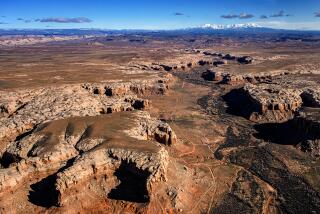Alanah Woody, 51; preserved rock art in Nevada
- Share via
Alanah Woody, a scholar in the study of rock art who helped lead efforts to protect ancient American Indian petroglyphs and pictographs, has died. She was 51.
Woody, who taught anthropology and archeology at the University of Nevada, Reno, died Thursday, a few days after becoming ill, her family told the Reno Gazette-Journal. The cause of death was heart failure, the Associated Press reported.
As co-founder and executive director of the Nevada Rock Art Foundation, Woody was credited with mobilizing a small army of volunteers to record Nevada’s vast collection of carvings and drawings known as petroglyphs and pictographs.
About a third of Nevada’s 1,500 known rock sites have been recorded professionally. Some of the sites are small, such as those that have a few faint lines carved on a boulder; others are much bigger, including an 80-acre canyon with nearly 10,000 petroglyphs.
Most early Nevada rock art is abstract and made by hunter-gatherers who could have been marking territory, telling stories or trying to lure animals to waiting hunters.
“I am a rock art evangelist,” Woody told Smithsonian magazine in 2005. “Give me people who think rock art is nothing more than a bunch of old graffiti on a boulder or cave wall. Let me take them out into the desert to see 10,000-year-old petroglyphs, and I guarantee they’ll begin to feel a connection with the people who lived here long before we came along.”
In May, Woody received a Nevada Historic Preservation Award for her work in preserving the state’s ancient heritage. She also managed the anthropology collections at the Nevada State Museum in Carson City.
Woody was born in the Central Valley, the daughter of a hard-rock miner who worked on water tunnels and large construction projects. She traced her interest in other cultures to living in Pakistan from age 5 to 13.
She came to Nevada “for the same reason a lot of people do -- to get a divorce,” she said in the Smithsonian article.
With a son to support, she took an anthropology course and discovered her life’s work. After receiving bachelor’s and master’s degrees in anthropology from the University of Nevada, Reno, Woody earned a doctorate in archeology in 2000 from the University of Southampton in England. She formed the rock art foundation a year later.
“Nevada may be the last best place for rock art,” archeologist David Hurst Thomas of the American Museum of Natural History in New York said in the Smithsonian article. Woody tapped “public interest in it in a way that nobody in the professional archeology community could do before.”
She is survived by her husband, Angus Quinlan; her son, Christopher; her father; and two brothers.
More to Read
Sign up for Essential California
The most important California stories and recommendations in your inbox every morning.
You may occasionally receive promotional content from the Los Angeles Times.













